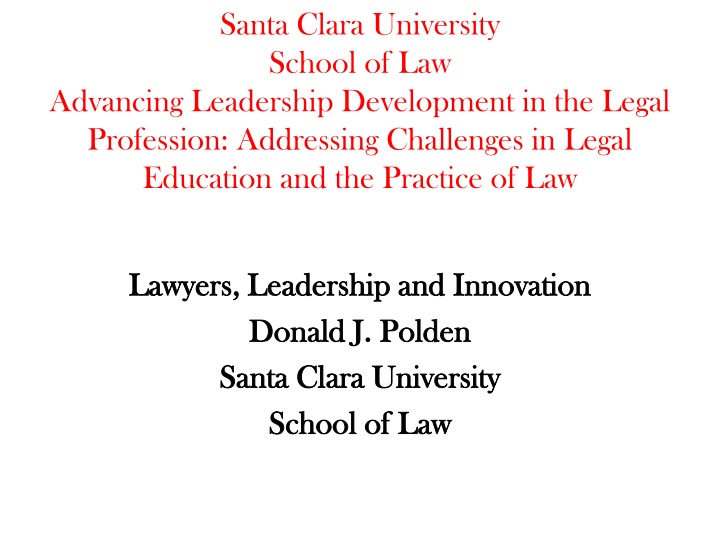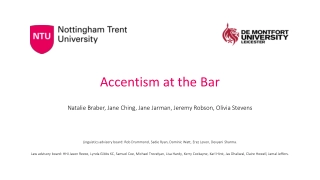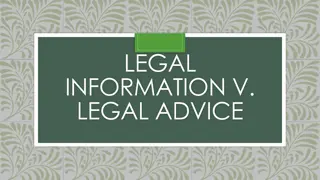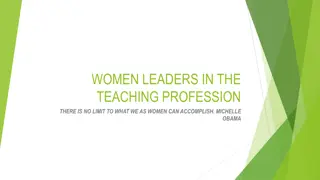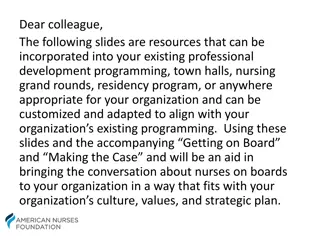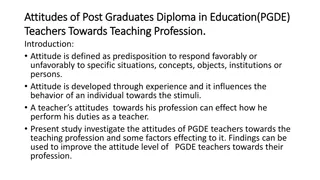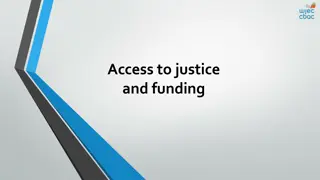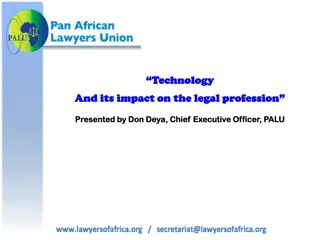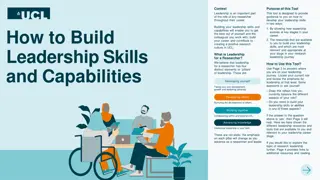Advancing Leadership Development in the Legal Profession: Addressing Challenges in Legal Education
Leadership matters in the legal profession, exploring theories applicable to lawyers, the need for change, challenges in lawyer organizations, and the importance of innovation processes during crisis and challenging times.
Download Presentation

Please find below an Image/Link to download the presentation.
The content on the website is provided AS IS for your information and personal use only. It may not be sold, licensed, or shared on other websites without obtaining consent from the author.If you encounter any issues during the download, it is possible that the publisher has removed the file from their server.
You are allowed to download the files provided on this website for personal or commercial use, subject to the condition that they are used lawfully. All files are the property of their respective owners.
The content on the website is provided AS IS for your information and personal use only. It may not be sold, licensed, or shared on other websites without obtaining consent from the author.
E N D
Presentation Transcript
Santa Clara University School of Law Advancing Leadership Development in the Legal Profession: Addressing Challenges in Legal Education and the Practice of Law Lawyers, Leadership and Innovation Lawyers, Leadership and Innovation Donald J. Donald J. Polden Santa Clara University Santa Clara University School of Law School of Law Polden
Lawyers, Leadership and Innovation Lawyers and Leadership Leadership is for everyone and leadership matters Leadership is a function of relationship between leader and followers, such as when leader inspires his or her followers to take on critical activities and tasks. Leading change in the profession and in law firms and corporate legal departments Lawyers as CEOs Significant role of lawyers in legal profession (e.g., Deborah Rhode analysis of high percentage of legal trained people in key government, business, non-profit and similar positions)
Lawyers, Leadership and Innovation Theories of leadership applicable to lawyers: Transformations fundamental, significant change in organizations and groups; arguably this is the type of leadership needed in legal education; Servant leadership not focused on the power at the top of organization but rather on how to help others to develop their professional growth; Adaptive leadership facilitates the mobilization of group or constituents to address a challenge a need for change but within the culture of the organization and taking into account the members strengths, weaknesses and need.
Lawyers, Leadership and Innovation Why change needed? Challenges to lawyer organizations? Answer: The business of law and practice of law is a mess!! Growth of alternative providers (disruption) Reticence of clients to pay high costs (outside of bet the company litigation) Low cost models of legal services (e.g., doc review centers by national law firms doing litigation) From 2000 to 2016, too many new law school graduates; input market for law talent cratered, but also the number of smart people electing to go to law school declined by half; Disappointment that new graduates don t have skills that clients/cases need and firms don t have resources (or will) to provide them for young lawyers;
Lawyers, Leadership and Innovation Innovation Processes During crisis and challenging times there is a premium on leadership skills that permit the leader to focus on innovation around the difficulties and uncertainty that paralyzes the rest of the organization, market or industry. [D. Polden 2016] The innovator s method requires discipline, perseverance and dedicated effective leadership in such difficult times. [Furr and Dyer, 2014] Difficulties in leading innovation change: Desire to accelerate; speed up recovery Infirmities in group dynamics leads to delay, polarization of team, and amplification of errors [Sunstein & Hastie, 2014] Inability of objects of innovation (e.g., law firms) to make meaningful, intelligent change; resistance; always done it this way
Lawyers, Leadership and Innovation Ingredients to process of creative change (John Kotter, Leading Change 1995): Establish sense of urgency about challenge or problem Identify guiding group or coalition to address Create a clear vision for change Identification of actions to address the problem Communicating the vision and encouraging buy in of key constituents
Lawyers, Leadership and Innovation Ingredients to process of creative change (con t): Experiment with key components and breakthrough actions Creating improvements to plan so team has wins Roll out (institutionalize) new program or activities within the culture of organization
Lawyers, Leadership and Innovation Demonstrated innovation in legal education: Enhanced curricular innovation in teaching and developing critical lawyering skills; beyond the McCrate Report recommendations Formation of AALS Section on Leadership President Hilarie Bass new Commission on the Future of Legal Education (https://www.americanbar.org/groups/leadership/offi ce_of_the_president/futureoflegaleducation.html)
Lawyers, Leadership and Innovation Demonstrated innovation in legal education Focus on success of graduates on bar examination and on competencies that their future employers value (competency based education) Revised curricula at some schools, emphasizing leadership, practice competencies, technology awareness, and on the formation of professional values (see N. Hamilton pioneering work) Recent attempts to revise how process of accreditation of law schools can advance the missions of almost 200 (and declining!) schools.
Lawyers, Leadership and Innovation Innovation (disruptive or incremental) through leadership in practice of law and delivery of legal services: More lawyer CEO s [Henderson, HBR, 2017] Clients expect law firms to make strategic and long-term investments in Operational Excellence. Clients expect law firms to understand their own business operations inside and out, and again, be continuously improving upon them. Clients expect law firms to provide high-value services and advice/insights based on specific experience in their industry, geography or problem space. But law firms, esp. large, national ones are conservative and adhere to business as usual . And per partner profits range from $3M to $5.8M among 15 most profitable American law firms. Pressure is to pay the profits out and not invest in firm- innovation. Richard Susskind says: It is hard to tell a room of millionaires that they might have their business model wrong.
Lawyers, Leadership and Innovation Innovation (disruptive or incremental) through leadership in practice of law and delivery of legal services: Law firm challenges include talent retention, managing technology, adapting to need for constant innovation in pricing and delivery of services (managing change). In survey of many clients, only 9% said that the technology used by their law firms was used in a way that improved the way that work was done Attracting talent: since 2010 there has been a decrease of 50% in the number of smart people deciding to go to law school; where is tomorrow s law firm talent coming from? Internationalization of law practice (and many argue that foreign law firms are innovating much more effectively than US firms)
Lawyers, Leadership and Innovation Where is innovation in practice of law being seen? Baker & McKenzie forgoes heavy payout of profits to partners and invests in long term projects (including R&D and hiring a futurist ) that will benefit firm in future; Latham is investing in how AI can strengthen the Latham platform in five to ten years so partners will have the tools they need; Orrick initiated Orrick Analytics to develop the capacity to do data analytics (such as influence of block chain technology on how law will be practiced) See Future Times, North America Innovative Lawyers (December 2017) for analysis of most innovative US law firms
Lawyers, Leadership and Innovation Closing Comments (and you ll need to read the full article in SCLR symposium issue!): Legal education and the legal profession are facing unprecedented challenges; challenges that require frank assessment of their business, educational, and public service missions; they are existential challenges Both institutions must innovate to survive Innovation requires leadership; leadership to conceive of a better future and the skills to influence positive, ethical change. We hope this Symposium is another step in that process of developing leadership for the future.
